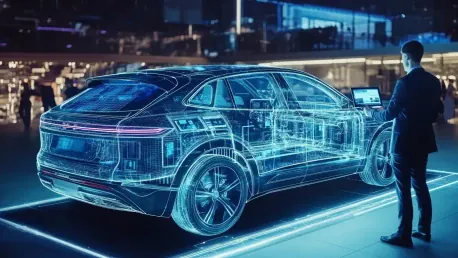The rise of electric vehicles (EVs) has brought about a need for efficient and user-friendly charging solutions. As the adoption of EVs continues to grow, the integration of Internet of Things (IoT) technology into charging infrastructure is becoming increasingly important. A seamless, competitive charging experience akin to traditional gasoline refueling is paramount for EVs to gain widespread acceptance. This article explores how IoT can enhance and secure the EV charging experience, making it more competitive with gasoline refueling and attracting more users.
The Importance of Public Charging Infrastructure
Addressing the Need for Convenience
For EVs to gain widespread adoption, public charging stations must be as convenient and seamless as gasoline refueling. Many potential EV buyers do not have access to home charging, making public infrastructure crucial, especially for long road trips and high-use scenarios like ride-hailing. IoT integration can simplify various aspects of the charging process, such as handling contactless payments through the car’s infotainment system and providing continuous updates on the availability of charging stations.
Enhancing convenience and reliability through IoT is central to ensuring a seamless experience at public charging stations. Automakers and charging operators can leverage IoT to provide real-time information on charger availability, demand at specific locations, and pricing, which helps drivers avoid frustrating peak hour rates and downtime. This is especially relevant for long trips and high-usage contexts, where timely access to charging can make or break a journey. The seamless integration of IoT thus promises to transform the overall experience, taking it closer to the hassle-free gasoline refueling most drivers are accustomed to.
Enhancing the Driver Experience
IoT technology can significantly enhance the driver experience by offering smarter, more efficient, and feature-rich charging solutions. For instance, drivers can receive real-time information on charger availability, demand at specific locations, and pricing. This helps avoid the frustration of encountering peak-hour rates unexpectedly. Additionally, IoT can enable payment through the car’s infotainment system, eliminating the need for multiple charging apps and on-site QR codes.
Personalized recommendations become a reality with IoT integration into vehicle systems, potentially transforming the charging process entirely. By pairing with cloud-based AI voice assistants, drivers could get notifications when their charge is low and directions to the nearest suitable charging station tailored to their needs. These assistants can even suggest charging stations near desired amenities like restaurants, ensuring a comfortable and efficient journey. As the technology evolves, the driver experience is set to improve significantly, providing features and benefits previously unimagined in the traditional gasoline refueling paradigm.
Benefits for Charging Operators
Maximizing Uptime and Efficiency
From the perspective of charging operators, IoT helps maximize the uptime of their largely unmanned networks by allowing for remote monitoring and management. This includes tracking data usage, accessing real-time data and analytics, and boosting operational efficiency through a multi-tenant system. By ensuring continuous communication and reducing downtime, operators can address a significant revenue concern and provide a more reliable service to consumers.
The operational benefits of IoT for charging operators cannot be overstated. By leveraging IoT tools, operators can monitor their infrastructure and make data-driven decisions that optimize performance. Predictive maintenance powered by continuous data streams can preemptively address issues before they cause significant downtime, ensuring the network’s reliability. Real-time data also aids in resource allocation, making it easier for operators to meet fluctuating demands efficiently. These factors collectively enhance the operational viability of EV charging networks, positioning them as reliable and user-friendly alternatives to traditional fueling stations.
Enhancing Security and Reliability
Ensuring the reliability of consumer touch points, such as charging docks and payment systems, is crucial for a seamless user experience. IoT technology can help build robust security measures to prevent exploitation by malicious actors. For example, OptConnect offers router products aimed at enabling secure and fast IoT connectivity within EV chargers. This allows operators to monitor their devices remotely and maintain continuous communication, thereby reducing downtime and enhancing security.
Robust security measures facilitated by IoT are essential in countering various emerging threats to charging infrastructure. Advanced encryption and secure communication protocols ensure that user data, including payment information, remains protected from cyberattacks. Additionally, remote monitoring enabled by IoT allows for quick identification and response to suspicious activities, further bolstering security. These initiatives collectively contribute to a safer, more reliable charging ecosystem, fostering consumer trust and encouraging broader adoption of EVs.
Leveraging IoT for Feature-Rich Charging Solutions
Unified Payment Systems
One of the key ways automakers can leverage IoT to enhance the charging experience is by enabling payment through the car’s infotainment system. This would eliminate the need for drivers to use various on-site QR codes and multiple charging apps. A unified payment approach would improve consumer sentiment and streamline the charging process. While some experts propose a unified app for all charging operators, integrating this functionality directly into the vehicle using near-field communication is considered more practical.
The practical benefits of a unified payment system extend beyond mere convenience. Simplified payment processes can significantly enhance user satisfaction, reducing the friction commonly associated with the current scattered approaches. Drivers can benefit from faster, more secure transactions, fostering a smoother and more reliable payment experience. Furthermore, automakers could potentially integrate reward programs or additional features that further incentivize EV adoption and frequent charging, enhancing the overall value proposition of electric mobility.
Real-Time Updates and Personalized Recommendations
Further integration of charging networks into the vehicle’s infotainment system and backend servers can unlock a range of possibilities aimed at enriching and streamlining the charging process. For example, connecting the vehicle to a universal grid network through IoT would provide drivers with up-to-date information on charger availability, demand at specific locations, and pricing. Additionally, integrating this system with a cloud-based generative AI voice assistant could notify drivers when their vehicle’s charge is low and guide them to the nearest suitable charging station. If the driver mentions they are hungry, the assistant could refine the search to stations near restaurants, and the car’s mapping system could then provide the optimal route.
The synergy between real-time updates and generative AI holds immense promise for revolutionizing the EV charging process. By continuously evolving and learning from driver habits, AI systems can offer increasingly accurate and relevant suggestions, making the driving experience more enjoyable and efficient. This personalization can include recommendations on optimal charging times to save costs, avoid queues, or even receive discounts. Such innovative features dramatically enhance the user experience, fostering higher levels of satisfaction and loyalty among electric vehicle users.
Overcoming Current Challenges
Rapid Expansion and IoT Integration
The rapid expansion of charging infrastructure has limited the ability of automakers and operators to fully leverage IoT’s potential. This situation is likened to building the wings of an aircraft while flying it. However, fully capitalizing on IoT opportunities could significantly enhance the security, reliability, and overall user experience of EV charging. By focusing on these technological advancements, the industry can overcome some of the current challenges and provide a superior charging experience for EV users.
Achieving full IoT integration while rapidly expanding infrastructure requires a balanced approach. Stakeholders must address interoperability challenges to ensure seamless communication between different devices and networks. Standardizing protocols and adopting a collaborative approach can facilitate smoother integration, enabling broader utilization of IoT capabilities. As the industry continues to grow, prioritizing IoT integration will be key to unlocking its full potential, ensuring that the charging experience remains efficient, secure, and scalable.
Collaboration Between Automakers and Charging Operators
The growing popularity of electric vehicles (EVs) has created a demand for efficient and user-friendly charging solutions. As more people adopt EVs, integrating Internet of Things (IoT) technology into charging infrastructure is becoming increasingly critical. For EVs to achieve widespread acceptance, the charging experience must be seamless, reliable, and competitive with traditional gasoline refueling. This means charging stations should be as convenient and quick as filling up at a gas station.
IoT technology can play a significant role in enhancing the EV charging experience. By connecting charging stations to a network, IoT can optimize energy distribution, monitor real-time usage, and provide users with important information like wait times or availability. Additionally, IoT can enhance security by detecting potential issues and preventing unauthorized access. Ultimately, creating a better charging experience involves using IoT to make EV charging more efficient, secure, and user-friendly, helping to attract more users and increase the overall adoption of electric vehicles.









